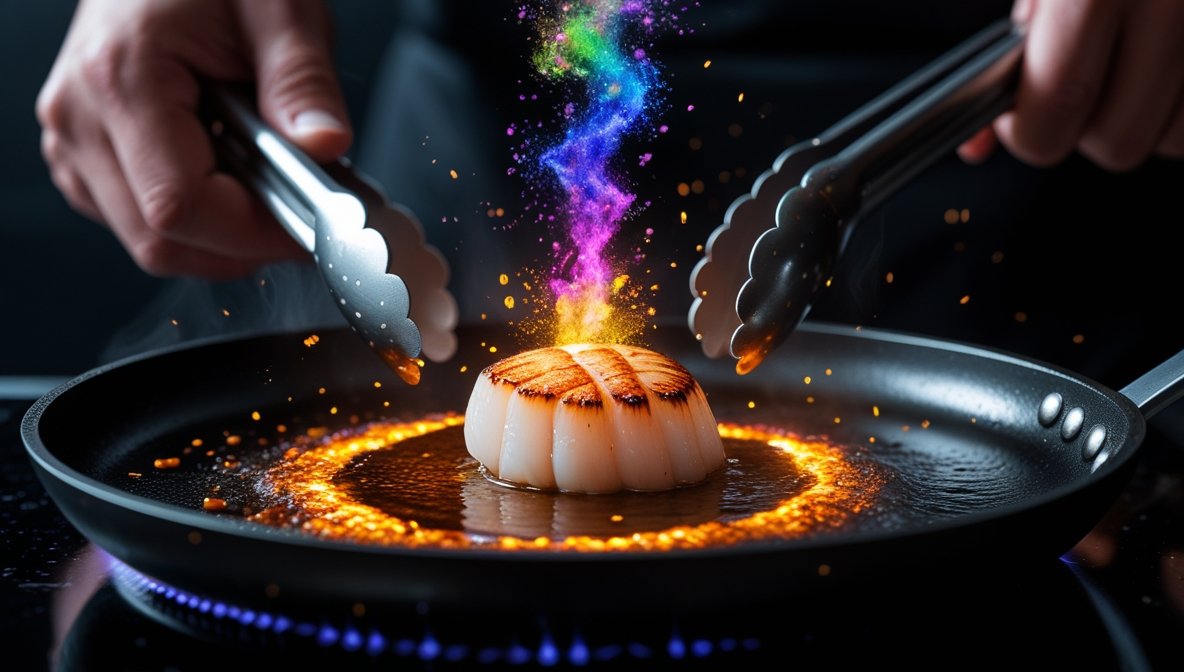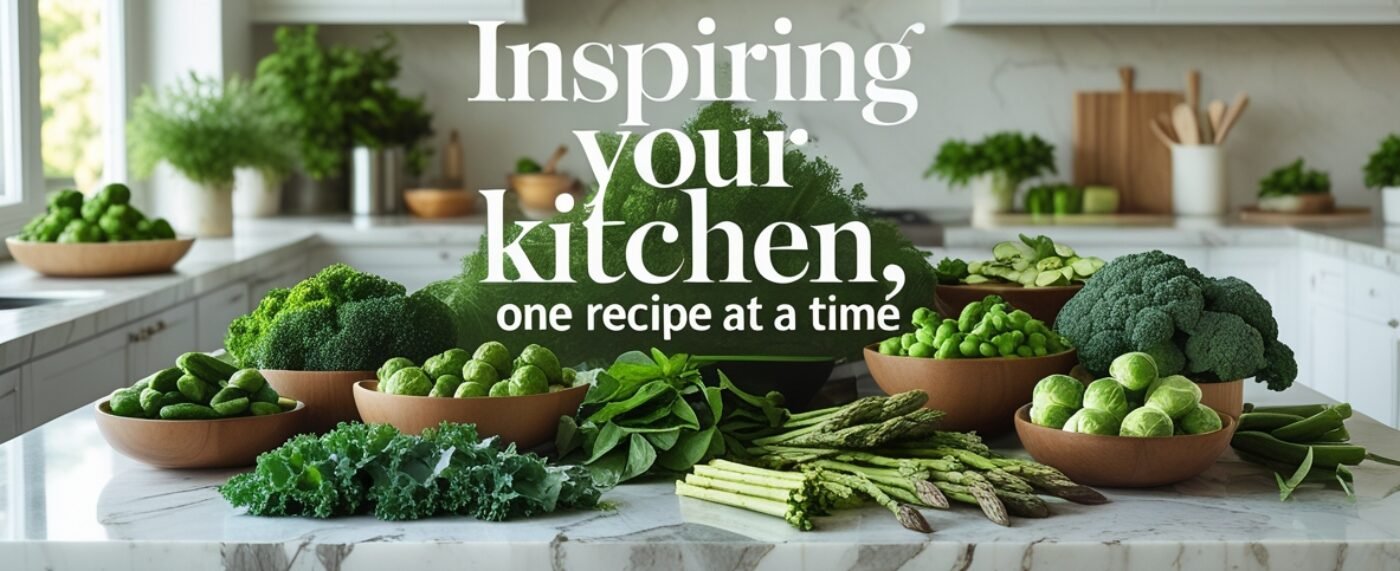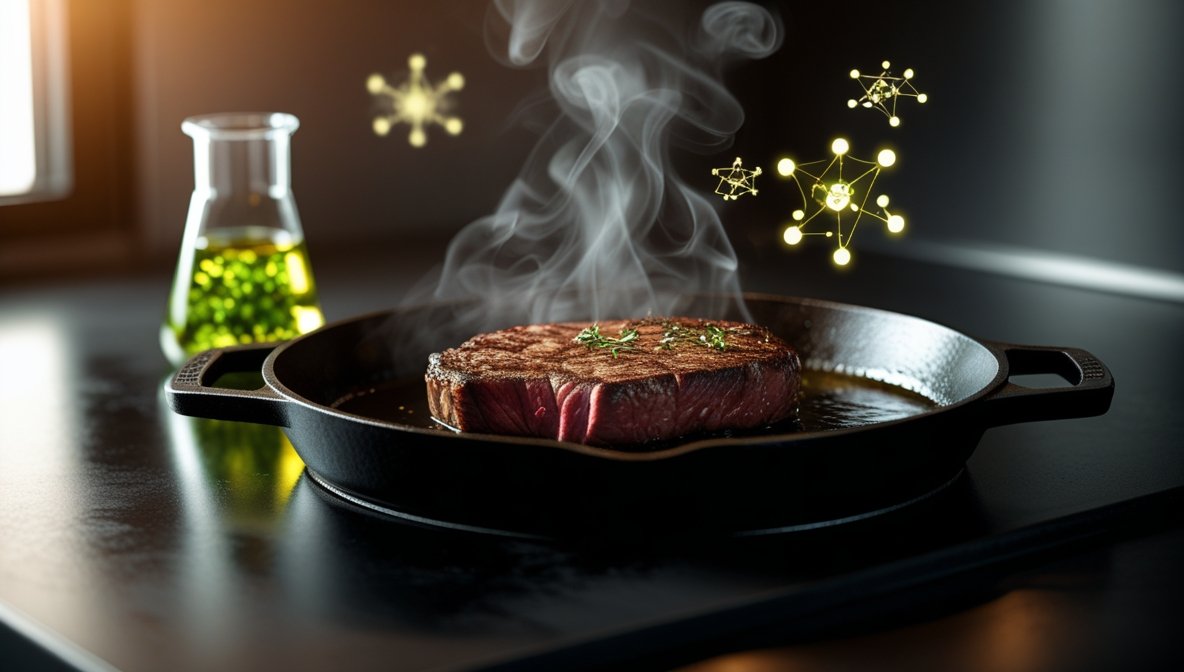Your Kitchen is a Laboratory: A Cheat Sheet to the Science of Cooking
Cooking is one of the most accessible forms of applied chemistry and physics. Understanding the fundamental principles behind why techniques work will transform you from someone who just follows recipes into a confident, intuitive cook.
This is your cheat sheet to the science of flavor and technique.
Part 1: The Science of Flavor – What Are We Actually Tasting?
Flavor is a complex symphony, not a single note. It’s a collaboration between your tongue (taste) and your nose (aroma).
Taste: The Five Pillars on Your Tongue
Your taste buds are built to detect five basic categories:
-
Sweet: Detects sugars. Signals energy-rich food (fruits, honey, carbs).
-
Salty: Detects sodium chloride. Essential for bodily function, and it also enhances other flavors by suppressing bitterness.
-
Sour: Detects acidity (like in lemon juice or vinegar). Signals ripeness or potential spoilage. Used in cooking to “brighten” and balance rich, fatty flavors.
-
Bitter: Detects a wide range of compounds. Often a warning signal for toxins in nature, but in small, controlled amounts, it adds complexity (coffee, dark chocolate, bitter greens).
-
Umami: Detects glutamates. A savory, meaty, deeply satisfying taste found in mushrooms, soy sauce, aged cheeses, and seared meats. It signals protein.
Aroma: The Secret to Complex Flavor
If taste is the foundation, aroma is the intricate architecture built on top. When you chew, you release volatile organic compounds (VOCs)—tiny airborne molecules that travel up the back of your throat to your olfactory receptors.
This is why food tastes bland when you have a cold. Your tongue can still detect sweet, salty, and sour, but your blocked nose can’t pick up the thousands of aromatic compounds that differentiate a strawberry from a raspberry.
How We Create Flavor: The Key Chemical Reactions
You aren’t just combining ingredients; you’re creating new flavor molecules through chemical reactions. The two most important are:
-
The Maillard Reaction: This is the holy grail of flavor. It’s a complex chemical reaction between amino acids (from proteins) and reducing sugars that occurs when food is heated to around 300°F / 150°C. It’s responsible for the delicious browning and complex, savory flavors on a seared steak, toasted bread crust, roasted coffee beans, and fried onions. Key takeaway: For Maillard to happen, the surface of your food must be dry and the heat must be high enough.
-
Caramelization: This is a simpler reaction involving only the browning of sugar. When sugar is heated, its molecules break down and reform into new compounds with a deep, nutty, and slightly bitter flavor. It’s what makes caramelized onions sweet and complex and gives caramel sauce its signature taste.
Part 2: The Science of Technique – Putting Chemistry into Action
Every cooking technique is a method of controlling heat and chemical reactions to achieve a desired texture and flavor.
Understanding Heat Transfer
-
Conduction: Direct heat transfer. The pan gets hot, and the food touching the pan gets hot. This is searing in a nutshell.
-
Convection: Heat transfer through a fluid (air or water). A convection oven circulates hot air, cooking food faster and more evenly. Boiling water cooks pasta via convection.
-
Radiation: Heat transfer via electromagnetic waves. Think of the glowing coils of a broiler or the flames of a grill cooking the surface of your food.

Common Techniques and the Science Behind Them
-
Searing: The Science: Using high, direct heat (conduction) to trigger the Maillard reaction on the surface of meat or vegetables. This creates a flavorful brown crust and a huge depth of flavor that you can’t get from boiling or steaming.
-
Braising & Slow Cooking: The Science: This technique uses low, moist heat (convection) over a long period. Its primary purpose is to break down collagen—the tough connective tissue in robust cuts of meat (like chuck roast or pork shoulder)—and convert it into rich, silky gelatin. This is why tough, cheap cuts of meat become fall-apart tender after hours in a slow cooker.
-
Emulsifying (e.g., Vinaigrette & Mayonnaise): The Science: Oil and water famously don’t mix. An emulsion is a forced mixture of these two liquids. To stabilize it, you need an emulsifier—a molecule that has a water-loving end and an oil-loving end. In vinaigrette, mustard acts as a weak emulsifier. In mayonnaise, the lecithin in egg yolks is a powerful emulsifier that creates a thick, creamy, and stable sauce.
-
Blanching Vegetables: The Science: Quickly boiling vegetables and then plunging them into ice water does two things. The brief heat deactivates the enzymes that cause vegetables to lose their color, turn brown, and get mushy. The ice bath (shocking) immediately stops the cooking process, locking in that vibrant color and crisp-tender texture.
The Kitchen Scientist’s Cheat Sheet: Actionable Tips & The “Why”
| If You Want To… | The Action | The Science Why |
| Get a perfect, brown crust on meat | Pat your meat completely dry with paper towels before cooking. Don’t overcrowd the pan. | The Maillard reaction can’t begin until all surface moisture has evaporated. If the pan is crowded, the food will steam instead of sear. |
| Have flavorful pasta, not just a flavorful sauce | Salt your pasta water generously. It should taste like the sea. | Osmosis. The salt seasons the pasta from the inside out as it cooks. It’s your only chance to flavor the pasta itself. |
| Make a juicy steak or roast | Let your meat rest for 5-10 minutes after cooking before slicing it. | When meat cooks, the muscle fibers tighten and push juices to the center. Resting allows the fibers to relax and reabsorb those juices, preventing them from spilling out onto your cutting board. |
| Make any rich or fatty dish taste better | Add a splash of acid (lemon juice, vinegar) at the end. | Acidity cuts through and balances fat, salt, and richness. It “wakes up” the other flavors on your palate, making the dish taste brighter and less heavy. |
| Make a non-clumpy vinaigrette | Add the oil very slowly to the vinegar/mustard while whisking constantly. | You are creating an emulsion. Adding oil too quickly will “break” the sauce, as the emulsifying agent (mustard) can’t keep up with incorporating the fat droplets. |
| Cook vegetables evenly | Cut your vegetables into uniform sizes. | All pieces will cook at the same rate due to consistent surface area and volume, ensuring none are mushy while others are still raw. This is about controlling heat transfer. |
From Recipe Follower to Fearless Cook
By understanding the “why” behind the “how,” you can start to predict what will happen. You’ll know how to fix a dish that tastes flat (add salt or acid!), how to get a better crust on your chicken, and why your stew is so much better the next day (flavor molecules have had time to meld).
So next time you step into your kitchen, remember: you’re not just making dinner. You’re running a delicious experiment.

